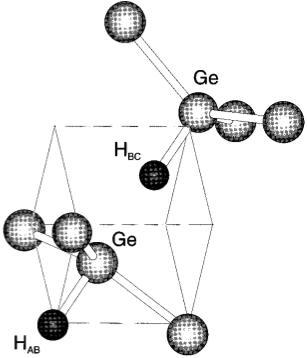 Local modes of the H2 dimer in germanium
Local modes of the H2 dimer in germanium
Local vibrational modes of the H*
2 defect in crystalline germanium are identified by a combination of infrared-absorption spectroscopy, uniaxial stress measurements, and ab initio theory. Germanium crystals are implanted with protons and/or deuterons at 300 K, and subsequently annealed at room temperature. A number of local vibrational modes of hydrogen are revealed by infrared-absorption spectroscopy. In particular, modes at 765, 1499, 1774, and 1989 cm−1 originate from the same defect which has trigonal symmetry according to the uniaxial stress measurements. The 765 cm−1 mode is two dimensional, while the 1774 and 1989 cm−1 modes are one dimensional. Measurements on samples coimplanted with protons and deuterons show that the defect contains a pair of weakly coupled and inequivalent hydrogen atoms. The 765, 1499, 1774, and 1989 cm−1 modes are ascribed to the H*
2 defect. The 765 cm−1 mode is a Ge-H bend mode with an overtone at 1499 cm−1 and the modes at 1774 and 1989 cm−1 are Ge-H stretch modes. An excellent fit to the stretch frequencies is obtained with a simple model based on two coupled Morse-potential oscillators. In addition, the model gives intensity ratios in fair agreement with those observed. The structure, the local-mode frequencies, and the isotope shifts of H*
2 are calculated with ab initio local-density-functional cluster theory. The theoretical frequencies are consistently 5-10% too high, as expected from the theory which often leads to overbinding. The isotope shifts, however, are in fair agreement with observations. These results provide additional support for our assignments, and show that the 765 and 1774 cm−1 modes primarily involve the hydrogen at the antibonding site, while the 1989 cm−1 mode is related mainly to vibration of the hydrogen near the bond-center site.